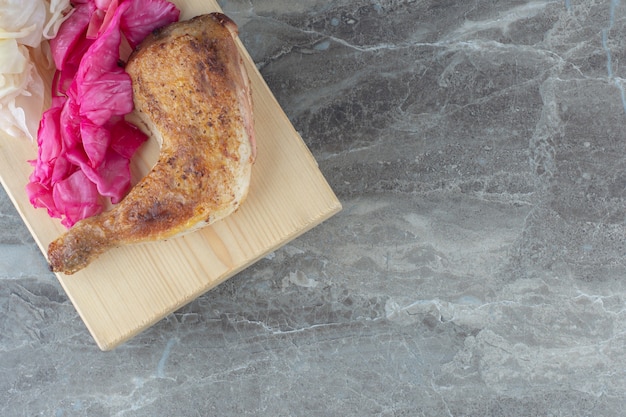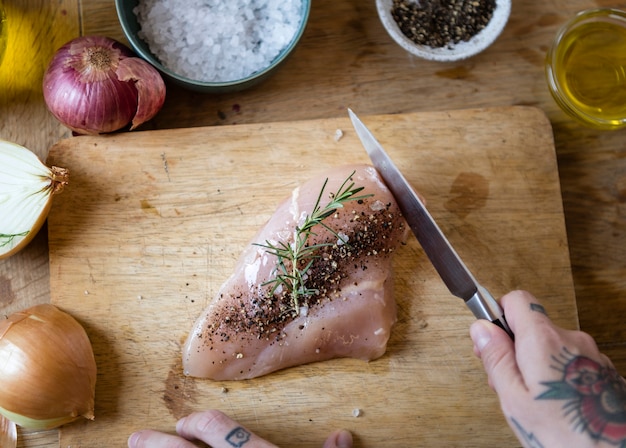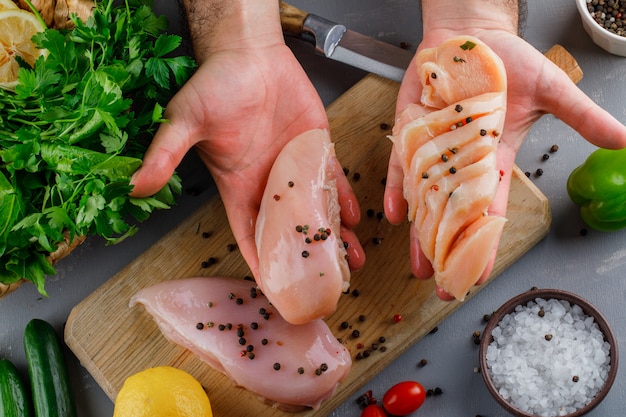Chicken tenderloins - they're the ultimate culinary chameleon, right? They're perfect for a quick weeknight dinner, a fancy appetizer, or even a hearty lunch. But let's be honest, getting them just right can be a bit of a dance. Overcooked, and they're as dry as the Sahara. Undercooked? Well, let's just say you might not want to risk it. So, grab your apron, dear reader, because I'm going to spill all my secrets for achieving perfectly cooked chicken tenderloins, every single time.
Part 1: Demystifying the Chicken Tenderloin

First things first, let's get familiar with our star ingredient. Contrary to popular belief, these aren't actually tenderloins. They're actually the pectoralis minor muscle, a small, delicate piece found alongside the breast. Think of it as a little sibling to the chicken breast. This makes them leaner and quicker to cook, which is why they're a favourite for busy cooks like myself.
The Tenderloin's Anatomy: Understanding the Structure
Imagine those chicken tenderloins as a bunch of tiny muscle fibres tightly bundled together. That's why they can dry out easily if they're overcooked. You need to be mindful of the cooking time, treat them with care, and ensure they stay juicy and tender. It's all about a little culinary finesse.
Part 2: Gathering Your Arsenal: Essential Tools and Ingredients

Before we dive into the nitty-gritty of cooking times, let's gather our essentials. Nothing fancy here, just the basics, but they're crucial for a successful cooking adventure.
Essential Tools: Your Culinary Companions
- A trusty cutting board: For prepping and slicing those tenderloins. I like a sturdy wooden one, but a plastic one will do the trick.
- A sharp knife: You need a good knife to make precise cuts, especially when dealing with delicate chicken tenderloins. A chef's knife is my personal favourite.
- Measuring spoons and cups: Essential for precise measurements. You don't want to end up with a salty disaster, do you?
- A large skillet or pan: For cooking, ideally non-stick. This will prevent your tenderloins from sticking and help you achieve that beautiful golden brown crust.
- A trusty meat thermometer: The ultimate weapon against overcooked chicken! This is a must-have for any serious cook.
Essential Ingredients: The Building Blocks
Now, for the main event. We're going to keep it simple here, focusing on the essentials. Remember, less is often more, especially when it comes to seasoning.
- Chicken tenderloins: Fresh is best, but frozen will do in a pinch. Make sure they're thawed completely before cooking. Frozen tenderloins take a little longer to cook, so keep that in mind.
- Olive oil or butter: For a touch of flavour and to prevent sticking. I prefer olive oil for its subtle flavour, but butter works just as well.
- Salt and pepper: The magic duo for seasoning. Don't be shy with the salt, it really brings out the flavour of the chicken.
Feel free to get creative with additional ingredients. I love a sprinkle of paprika, garlic powder, or even a dash of cayenne for a bit of heat. But remember, the basics are all you really need to make delicious chicken tenderloins.
Part 3: cooking chicken Tenderloins: Exploring the Methods

Now, let's get down to business. We're going to explore different cooking methods, each with its own charm and quirks. But keep in mind, the cooking time will vary depending on the method you choose and the size of your tenderloins. So, choose your method wisely!
3.1. Pan-Frying: The Classic Approach
This is a classic for a reason. It's quick, easy, and delivers a lovely golden brown crust. But be warned, it requires a little more attention than other methods.
3.1.1. Pan-Frying: Step-by-Step
- Seasoning: Start by generously seasoning your tenderloins with salt and pepper. Don't be shy!
- Heating the pan: Heat a tablespoon of olive oil or butter in a large skillet over medium-high heat. You want the pan hot enough to sear the tenderloins and create that beautiful crust.
- Adding the tenderloins: Carefully add the tenderloins to the hot skillet, making sure they're not crowded. You want to give them space to cook evenly and brown properly.
- Cooking time: Cook for 3-4 minutes per side, or until golden brown and cooked through. You want the internal temperature to reach 165°F (74°C). This is where that meat thermometer comes in handy.
- Resting: Remove from the heat and let the tenderloins rest for a few minutes before serving. This will allow the juices to redistribute and make them even more tender and juicy.
3.2. Baking: The Hands-Off Method
Perfect for large batches and a hands-off approach. Baking yields tenderloins that are moist and flavorful, and you can easily cook a whole bunch at once. It's a great option for a weeknight dinner or a party.
3.2.1. Baking: Step-by-Step
- Preheat: Preheat your oven to 375°F (190°C). This ensures the tenderloins cook evenly and get nice and golden brown.
- Prepare your baking sheet: Line a baking sheet with parchment paper. This will prevent sticking and make cleanup a breeze. You can also use a silicone baking mat for a similar effect.
- Season: Season your tenderloins with salt and pepper. Remember, a little salt goes a long way in bringing out the flavour of the chicken.
- Arrange on the baking sheet: Place the tenderloins on the prepared baking sheet, leaving a little space between them. This will allow for good airflow and ensure they cook evenly.
- Baking time: Bake for 15-20 minutes, or until the internal temperature reaches 165°F (74°C). Use your trusty meat thermometer to check the doneness.
- Rest: Remove from the oven and let them rest for a few minutes before serving. This will allow the juices to redistribute and make them even more tender and juicy.
3.3. Air-Frying: The Fast Lane to Deliciousness
This is a bit of a modern favourite, especially for those who love that crispy texture. It's a super-fast way to get crispy, juicy tenderloins, and it's much healthier than traditional deep frying. Just make sure you have an air fryer at your disposal.
3.3.1. Air-Frying: Step-by-Step
- Preheat: Preheat your air fryer to 400°F (200°C). This will ensure the tenderloins cook quickly and get that crispy exterior.
- Season: Season your tenderloins with salt and pepper. This adds flavour and helps to create a nice golden brown crust.
- Arrange in the basket: Place the tenderloins in the air fryer basket, making sure they're not crowded. You want to ensure good airflow and prevent overcrowding.
- Air-fry: Air-fry for 8-10 minutes, or until golden brown and cooked through. The internal temperature should reach 165°F (74°C), so use your meat thermometer to check for doneness.
- Rest: Remove from the air fryer and let them rest for a few minutes before serving. This will allow the juices to redistribute and make them even more tender and juicy.
Part 4: Timing is Everything: Deciphering the Cooking Time Code
Now, let's talk about the crucial element: cooking time. Remember, these are just guidelines, and you'll need to adjust based on the size and thickness of your tenderloins, the cooking method you've chosen, and the heat of your stove or oven. It's about learning to read the signs and understanding your equipment.
4.1. Pan-Frying: A Breakdown by Size and Thickness
For pan-frying, the cooking time is relatively short. Here's a breakdown by size and thickness:
| Size/Thickness | Approximate Cooking Time (Per Side) |
|---|---|
| Small (under 1/2 inch thick) | 3-4 minutes |
| Medium (1/2 - 3/4 inch thick) | 4-5 minutes |
| Large (over 3/4 inch thick) | 5-6 minutes |
But remember, it's always best to use a meat thermometer to ensure your tenderloins are cooked through to an internal temperature of 165°F (74°C). Don't rely solely on visual cues.
4.2. Baking: A Consistent Cooking Experience
Baking offers a more consistent cooking experience, but it takes a little longer than pan-frying. Here's a breakdown by size and thickness:
| Size/Thickness | Approximate Baking Time |
|---|---|
| Small (under 1/2 inch thick) | 15-18 minutes |
| Medium (1/2 - 3/4 inch thick) | 18-20 minutes |
| Large (over 3/4 inch thick) | 20-25 minutes |
4.3. Air-Frying: The Speed Demon
Air-frying is a game-changer for speed. It's much faster than baking or pan-frying, but it's essential to keep a close eye on them to prevent them from burning.
| Size/Thickness | Approximate Air-Frying Time |
|---|---|
| Small (under 1/2 inch thick) | 8-10 minutes |
| Medium (1/2 - 3/4 inch thick) | 10-12 minutes |
| Large (over 3/4 inch thick) | 12-15 minutes |
Part 5: Signs of Doneness: Deciphering the Culinary Clues
You're in the kitchen, your tenderloins are sizzling in the pan, and you're wondering if they're done. How do you know? It's a question we've all asked ourselves. Let's dive into the signs of doneness.
5.1. The Visual Check: A Look Says a Thousand Words
First things first, the visual cue. Look for a golden brown crust, a sign that the tenderloins have cooked properly and are ready to go. If you're cooking them in a skillet, they should be easily released from the pan without sticking. That's a good indication they're done.
5.2. The Touch Test: Feeling for Tenderness
Gently press on the tenderloin with your finger. It should feel firm to the touch, with no give. If it still feels soft, it needs more time in the pan, oven, or air fryer. But don't press too hard, you don't want to squish those little guys!
5.3. The Temperature Test: The Scientific Approach
This is where the meat thermometer comes in handy. It's the ultimate tool for ensuring safe and perfectly cooked chicken. Stick it into the thickest part of the tenderloin, making sure it's not touching any bones. It should register 165°F (74°C). Anything less, and it's not safe to eat.
5.4. The Juice Test: A Glimpse Inside
If you're still unsure, you can cut into the tenderloin. The juices should run clear, not pink or red. If they're pink or red, they need a bit more cooking time. But be careful with this one, as you don't want to overcook them by cutting them too many times. This is why it's best to use the meat thermometer for a reliable check.
Part 6: Mastering the Art of Tenderness: Unlocking the Secrets to juicy chicken
So, you've got your chicken tenderloins cooked to perfection, but they're still a little dry? Don't despair! There are a few tricks you can use to ensure they stay juicy and tender, even after cooking.
6.1. Marinating Magic: A Flavorful Soak
Before cooking, marinate your tenderloins in a flavorful mixture like olive oil, lemon juice, soy sauce, garlic, and herbs. This helps to keep them moist and adds incredible depth of flavour. It's like a little spa treatment for your chicken, making them more tender and flavorful.
6.2. The Basting Method: Adding Moisture While Cooking
While they're cooking, use a brush or spoon to baste them with melted butter, olive oil, or a flavorful sauce. This keeps them moist and prevents them from drying out. It's like giving them a little drink of flavour while they cook.
6.3. The Resting Ritual: Letting the Juices Redistribute
After cooking, let your tenderloins rest for a few minutes before slicing or serving. This allows the juices to redistribute, resulting in more tender, flavorful meat. It's like giving them a chance to recover from the heat and relax.
Part 7: Delicious Ways to Serve Chicken Tenderloins: A culinary adventure
Now that you've mastered the art of cooking chicken tenderloins, it's time to get creative with your serving options. Here are a few ideas to get your culinary juices flowing.
7.1. The Classic: A Timeless Combination
Simple and satisfying, pan-fried tenderloins with a side of mashed potatoes, steamed vegetables, and gravy. A timeless combination that's sure to please even the pickiest eaters. It's the ultimate comfort food.
7.2. The Asian Inspired: A Taste of the Orient
Try a stir-fry with tenderloins, vegetables, and a delicious Asian-inspired sauce. Think soy sauce, ginger, and sesame oil. A taste of the Orient in your own kitchen. It's a great way to add a little spice to your life.
7.3. The Gourmet Touch: Sophisticated and Flavorful
Get fancy with a salad topped with grilled tenderloins, crumbled goat cheese, and a balsamic vinaigrette. A sophisticated twist on a classic. It's perfect for a special occasion or a light summer meal.
7.4. The Finger Food Frenzy: Party-Ready Bites
For parties or gatherings, serve tenderloins as appetizers. Coat them in breadcrumbs and bake, or try a spicy honey glaze. Delicious and easy to grab, they're sure to be a hit with your guests. They're the perfect way to kick off a party or gather around the table.
Part 8: Avoiding Common Mistakes: Learning from Experience
You've got this, but a little knowledge can go a long way. Here are a few common mistakes to avoid so you can enjoy your tenderloins without any culinary mishaps.
8.1. Overcrowding the Pan: Giving Them Space to Breathe
If you cram too many tenderloins into the pan, they won't cook evenly and will likely end up dry. Give them space to breathe and cook properly. It's like a little bit of personal space for your chicken.
8.2. Not Reaching the Right Temperature: The Importance of Accuracy
Remember that 165°F (74°C) is the magic number for safe and perfectly cooked chicken. Don't rely on just visual cues, use a meat thermometer to ensure they're safe to eat. It's better to be safe than sorry, and a meat thermometer will give you peace of mind.
8.3. Cutting Them Too Much: Minimizing Moisture Loss
Over-cutting them while they're cooking can lead to excessive moisture loss and dry tenderloins. Limit the number of times you cut into them, and use a meat thermometer to check doneness. Let the thermometer do the work, and save the cutting for serving.
Part 9: FAQs: The Frequently Asked Questions
You've got questions, I've got answers. Let's tackle some of the most common queries about chicken tenderloins.
9.1. Can I Freeze Chicken Tenderloins?
Absolutely! You can freeze them for up to 3 months. Just make sure they're well wrapped in plastic wrap or freezer-safe bags to prevent freezer burn. This way, you can always have a stash of tenderloins ready to go for a quick and easy meal.
9.2. How Do I Thaw Frozen Tenderloins?
The safest method is to thaw them overnight in the refrigerator. You can also thaw them in a bowl of cold water, but ensure they're fully submerged and change the water every 30 minutes. This will prevent bacteria from growing and ensure they thaw evenly.
9.3. Can I Use Tenderloins for Chicken Nuggets?
Definitely! Cut them into smaller pieces, coat them in batter or breadcrumbs, and bake, fry, or air-fry. They're perfect for a delicious, homemade nugget experience. It's a fun and easy way to make a classic treat at home.
9.4. What About the Tenderloin's Color?
It's important to understand that the color of the chicken tenderloin can vary. Sometimes, the meat might have a slight grayish hue, especially if it's been frozen. This doesn't necessarily mean it's gone bad. If it smells fine and has been cooked to the proper temperature, it should be safe to eat. It's all about using your senses to determine freshness.
9.5. What Happens If I Overcook Chicken Tenderloins?
Overcooked chicken tenderloins will be dry and tough. While they're still safe to eat, they won't be as enjoyable. To avoid this, keep a close eye on the cooking time, use a meat thermometer, and follow the tips for ensuring tenderness. It's all about balance and precision in the kitchen.
So there you have it, everything you need to know about cooking chicken tenderloins. Remember, the key is to be mindful of the cooking time, use a meat thermometer, and try a few of the tips and tricks I've shared. With a little practice, you'll be a chicken tenderloin master in no time! Happy cooking!
Everyone is watching

How to Cook Frozen Lobster Tails Perfectly: A Step-by-Step Guide
RecipesLobster. Just the word conjures up images of lavish meals, special occasions, and a taste of luxury. But let's...

Pigs in a Blanket Cooking Time: How Long to Bake for Perfect Results
RecipesAh, pigs in a blanket. Just the name conjures up images of those delightful little parcels of crispy pastry en...

Pork Fillet Cooking Time: How Long to Cook It Perfectly
RecipesPork fillet, or tenderloin as it's sometimes called, is a real favourite in our house. It's so versatile, and...

The Ultimate Guide to Tender, Juicy Pulled Pork
RecipesRight, let's talk pulled pork. It's one of those dishes that just screams "comfort food," doesn't it? I mean...

The Ultimate Guide to Cooking Sweet Potatoes: From Roasting to Mashing
RecipesSweet potatoes. Just the name conjures up images of warm, comforting dishes, bursts of vibrant color, and a to...
